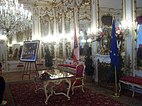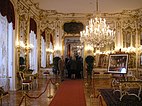Austrian President
The President of Austria (German: Bundespräsident der Republik Österreich) is the head of state of the Republic of Austria. Although theoretically granted great power by the Constitution, in practice the president is largely a ceremonial and symbolic figurehead.
The office of the president was established in 1920 after the collapse of the Austro-Hungarian Empire and the Habsburg Monarchy in 1918. As head of state, the president succeeded the president of the Constituent Assembly, the provisional post-monarchist legislature. Originally intended to be directly elected by the Austrian people through universal suffrage every six years, the president was appointed by the Federal Assembly until 1951, when Theodor Körner became the first popularly elected president.
Choice
The President of Austria is elected by popular vote for a six-year term and is limited to two consecutive terms. Voting is open to all persons eligible to vote in general parliamentary elections, which in practice it means that suffrage is universal for all Austrian citizens over the age of sixteen who have not been sentenced to a prison term of more than one year in prison. (Even so, they regain the right to vote six months after their release from prison.)
Until October 1, 2011, with the exception of members of any ruling or formerly ruling dynastic house (a precautionary measure against monarchical subversion, and directed primarily at members of the House of Habsburg), anyone with entitled to vote in elections to the National Council who is at least 35 years of age is eligible for the office of president. The exception of ruling or formerly ruling dynasties has meanwhile been abolished within the Wahlrechtsänderungsgesetz 2011 (Amendment to the Voting Rights Act 2011) due to an initiative by Ulrich Habsburg-Lothringen.
The president is elected under the two-round system. This means that if no candidate obtains an absolute majority (i.e. more than 50%) of the valid votes cast in the first round, a second ballot is held in which only the two candidates who obtained the highest number of votes can stand. in the first round. However, the constitution also provides that the group that nominates one of these two candidates may instead nominate an alternative candidate in the runoff. If there is only one candidate in a presidential election, the electorate has the opportunity to accept or reject the candidate in a referendum.
While in office, the president may not serve on an elected body or hold any other office.
Powers and duties
Presidential powers and responsibilities are established primarily by Federal Constitutional Law, additional powers may be defined by federal statute, judicial interpretations, and legal precedents.
Among these faculties are:
- The appointment of the Chancellor, Vice Chancellor and ministers who together form the Cabinet, as well as the dismissal of the same
- The appointment of federal government officials
- Enactment of legislation
- The dissolution of the National Council at the request of the Cabinet
- Dissolution of State diets at the request of the Cabinet and with the consent of the Federal Council
- The exercise of government by emergency decrees in times of crisis
- To be the enforcer of the decisions of the Constitutional Court
- The appointment of judges of the Constitutional Court, Supreme Court and Supreme Administrative Court, with the respective council of the National Council, Federal Council or Cabinet as the case may be.
- Negotiating and signing treaties with other countries; some treaties require the adoption of the National Council.
- He's the commander-in-chief of the country's Armed Forces.
- Creation and award of honorary and professional degrees (including: Promotio sub auspiciis Praesidentis rei publicae)
- It is entitled to annul criminal cases, grant pardons and commutations.
Incumbency
Immunity
The President enjoys full sovereign immunity from any form of official prosecution, including civil and criminal trials. The president can only be prosecuted with the explicit consent of the Federal Assembly. If a government authority intends to prosecute the president, it must submit an extradition request to the National Council. If approved by the National Council, the Chancellor must convene the Federal Assembly, which will then decide on the extradition request.
Removal
Popular deposition
The ordinary way to remove a sitting president would be through popular deposition. Since the president is elected by the people, the people also have the power to remove the president again through a plebiscite.
Impeachment
The president can be impeached before the Constitutional Court by the Federal Assembly for violating constitutional law. This process is triggered by a resolution of the National Council or the Federal Council. Following the approval of such a resolution, the chancellor must convene a session of the Federal Assembly, which then considers the removal of the president. A supermajority is needed to impeach the president, which means the attendance of at least half of the members of the National Council and the Federal Council is required as well as a successful two-thirds vote.
Succession
The Austrian Constitution does not provide for the office of vice-president. If the president becomes temporarily incapacitated (undergoes surgery, becomes seriously ill, or visits a foreign country (excluding EU member states), the presidential powers and duties vest in the chancellor for a period of twenty days, even if the chancellor he does not become 'interim president' during that time.
Residence
The president's main residence and workplace is the Leopoldine Wing in the Hofburg Imperial Palace, which is located in Vienna's Innere Stadt. The Leopoldine Wing is sometimes ambiguously referred to as the "Presidential Chancellery". In practice, the president does not actually reside in the Hofburg but retains his personal home.
Protection
The president is legally protected by multiple special provisions of criminal law; of which the most important is § 249 of the statutory Criminal Code:
Any person who attempts to force the President or dangerous threats or by using one of these means to coerce or prevent the exercise of his powers, in whole or in part, incurs a prison term of one to ten years.
Presidential Chancery
The president heads the Presidential Chancellery, a small body of the executive branch with the purpose of assisting the president in the exercise and fulfillment of his powers and duties. The Presidential Chancellery should not be confused with the Federal Chancellery, a government organization substantially larger executive that reports to the Chancellor. The Presidential Chancellery is the only governing body that the president directs without being limited by the requirement of advice and countersignature. The term "Presidential Chancellery" sometimes used interchangeably with "Ala Leopoldina", the seat of the president and the Presidential Chancellery.
List of presidents (1919-present)
| Political spectrum |
|---|
Social Democratic Workers’ PartySocial Christian PartyPatriotic FrontNSDAP |
| President of the Republic | Home | Fin | Party | Elections | ||||
|---|---|---|---|---|---|---|---|---|
| Republic of Germany (1919) | ||||||||
| Karl Seitz (1869-1950) | 5 March 1919 | 21 October 1919 | Social Democratic Workers’ Party | 1919 | ||||
| First Republic of Austria (1919-1934) | ||||||||
| Karl Seitz (1869-1950) | 21 October 1919 | 9 December 1920 | Social Democratic Workers’ Party | Election by Parliament | ||||
| Michael Hainisch (1858-1940) | 9 December 1920 9 December 1924 | 9 December 1924 9 December 1928 | Independent | |||||
| Wilhelm Miklas (1872-1956) | 9 December 1928 10 December 1934 | 10 December 1934 13 March 1938 | Social Christian Party | |||||
| Patriotic Front | ||||||||
| Arthur Seyß-Inquart (1892-1946) Acting President | 13 March 1938 | NSDAP | - | |||||
| Annex to the Third Reich (1938-1945) | ||||||||
| Second Republic of Austria (1945-current) | ||||||||
| Karl Renner (1870-1950) | 20 December 1945 | 31 December 1950 † | SPÖ | Election by Parliament | ||||
| Leopold Figl (1902-1965) Acting President as Foreign Minister | 31 December 1950 | 21 June 1951 | ÖVP | |||||
| Theodor Körner (1873-1957) | 31 December 1951 | 4 January 1957 † | SPÖ | 1951 | ||||
| Julius Raab (1891-1964) Acting President as Foreign Minister | 4 January 1957 | 22 May 1957 | ÖVP | - | ||||
| Adolf Schärf (1890-1965) | 22 May 1957 22 May 1963 | 22 May 1963 28 February 1965 † | SPÖ | 1957 1965 | ||||
| Josef Klaus (1910-2001) Acting President as Foreign Minister | 28 February 1965 | 9 June 1965 | ÖVP | - | ||||
| Franz Jonas (1899-1974) | 9 June 1965 9 June 1971 | 9 June 1971 24 April 1974 † | SPÖ | 1965 1971 | ||||
| Bruno Kreisky (1911-1990) Acting President as Foreign Minister | 24 April 1974 | 8 July 1974 | SPÖ | - | ||||
| Rudolf Kirchschläger (1915-2000) | 8 July 1974 8 July 1980 | 8 July 1980 8 July 1986 | Independent | 1974 1980 | ||||
| Kurt Waldheim (1918-2007) | 8 July 1986 | 8 July 1992 | ÖVP | 1986 | ||||
| Thomas Klestil (1932-2004) | 8 July 1992 8 July 1998 | 8 July 1998 6 July 2004 | ÖVP | 1992 1998 | ||||
| Andreas Khol (1941-) Chairman of the Interim National Council | 6 July 2004 | 8 July 2004 | ÖVP | - | ||||
| Barbara Prammer (1954-2014) Second President of the Interim National Council | SPÖ | |||||||
| Thomas Prinzhorn (1943-) Third President of the Interim National Council | FPÖ | |||||||
| Heinz Fischer (1938-) | 8 July 2004 8 July 2010 | 8 July 2010 8 July 2016 | SPÖ | 2004 2010 | ||||
| Doris Bures (1962-) Chairperson of the Interim National Council | 8 July 2016 | 26 January 2017 | SPÖ | - | ||||
| Karlheinz Kopf (1957-) Second President of the Interim National Council | ÖVP | |||||||
| Norbert Hofer (1971-) Third President of the Interim National Council | FPÖ | |||||||
| Alexander Van der Bellen (1944-) | 26 January 2017 | Present | Die Grünen | 2016 2022 | ||||
Timeline

Contenido relacionado
Annex: Mayors of Lobos
Annex: Municipalities of Oaxaca
Prince Edward Island
























